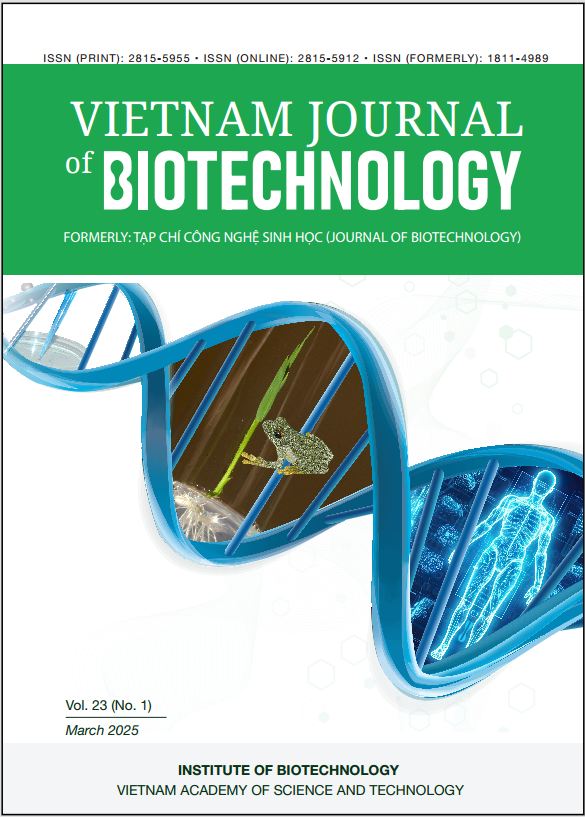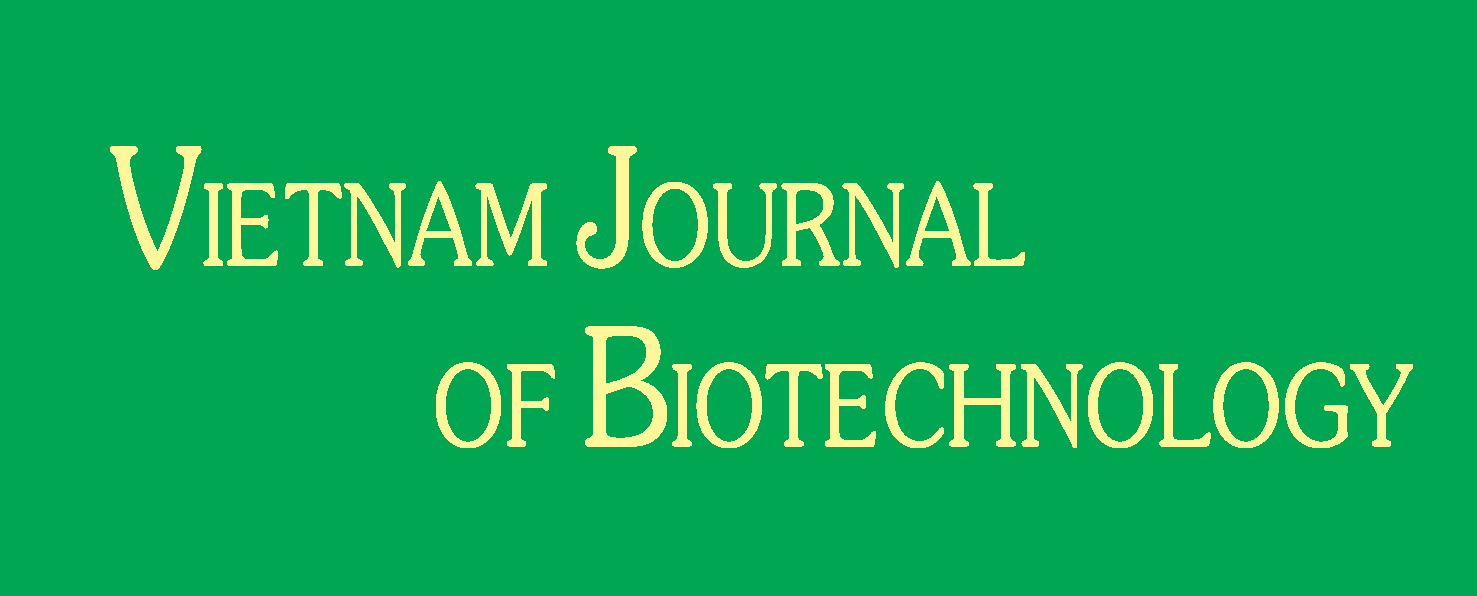Evaluation of antioxidant-related properties of six colored varieties of carrots (Daucus carota L.)
Author affiliations
DOI:
https://doi.org/10.15625/vjbt-21997Keywords:
Antioxidant activities, Daucus carota, DPPH, total flavonoid content, total phenolic contentAbstract
Carrots (Daucus carota L.) are a prevalent vegetable in human diet nutrition and are an excellent source of vitamins, alpha- and beta-carotene, and antioxidant compounds. Carrots are categorized primarily according to the pigmentation of their tuberous roots, which can range from white, yellow, orange, purple, and black. This study aims to determine the antioxidant-related properties of six carrot varieties collected in Vietnam, including the total phenolic content (TPC), the total flavonoid content (TFC), DPPH scavenging activity, and the antioxidant enzyme activities. The results showed that the black carrot extract had the lowest IC50 value whereas the highest belonged to the orange carrot. Furthermore, the findings revealed that black carrots exhibited the highest TPC, which was 1.24 ± 0.01 (g GAE/100 g sample) whereas the red-orange carrots had the lowest TPC, which was 0.3 ± 0.05 (g GAE/100 g sample). Additionally, the black carrots also had the highest TFC, which was 161.32 ± 1.68, and the red-orange carrots had the lowest TFC value which was 27.6 ± 0.80 (g QE/100 g DW). The antioxidant enzyme activities resulted in the highest peroxidase activity of black carrots (149.48 ± 2.25 U/mg protein) and the highest catalase activity of purple carrots (93.19 ± 3.28 U/mg protein). Phytochemical analysis indicates that black and purple carrots exhibit higher antioxidant potential, suggesting their applicability in treatments and as agents for food preservation.
Downloads
References
Akhtar, S., Rauf, A., Imran, M., Qamar, M., Riaz, M., and Mubarak, M. S. (2017). Black carrot (Daucus carota L.), dietary and health promoting perspectives of its polyphenols: A review. Trends in Food Science & Technology, 66, 36–47. https://doi.org/10.1016/j.tifs.2017.05.004
Baba, S. A., and Malik, S.A. (2015). Determination of total phenolic and flavonoid content, antimicrobial and antioxidant activity of a root extract of Arisaema jacquemontii Blume. Journal of Taibah University for Science, 9, 449–454. https://doi.org/10.1016/j.jtusci.2014.11.001
Bystricka, J., Kavalcova, P., Múilova, J., Vollmannová, A., Tóth, T., and Lenková, M. (2015). Carrot (Daucus carota L. ssp. sativus (Hoffm.) Arcang.) as source of antioxidants. Acta Agriculturae Slovenica, 10(2), 303-311. https://doi.org/10.14720/aas.2015.105.2.13
Cefola, M., Pace, B., Renna, M., Santamaria, P., Signore, A., and Serio, F. (2012). Compositional analysis and antioxidant profile of yellow, orange and purple polignano carrots. Italian Journal of Food Science, 24(3), 284-291.
Chang, L. W., Yen, W. J., Huang, S. C., and Duh, P. D. (2002). Antioxidant activity of sesame coat. Food Chemistry, 78, 347-354. https://doi.org/10.1016/S0308-8146(02)00119-X
Chen, T., and Zhang, B. (2016). Measurements of proline and malondialdehyde content and antioxidant enzyme activities in leaves of drought stressed cotton. Bio-protocol, 6. https://doi.org/10.21769/bioprotoc.1913
Czepa, A., and Hofmann, T. (2003). Structural and sensory characterization of compounds contributing to the bitter off-taste of carrots (Daucus carota L.) and carrot puree. Journal of Agricultural and Food Chemistry, 51, 3865–3873. https://doi.org/10.1021/jf034085+
Grassmann, J., Schnitzler, W. H., and Habegger, R. (2009). Evaluation of different coloured carrot cultivars on antioxidative capacity based on their carotenoid and phenolic contents. International Journal of Food Sciences and Nutrition, 58, 603–611. https://doi.org/10.1080/09637480701359149
Haq, R., and Prasad, K. (2017). Antioxidant activity, phenolic, carotenoid and color changes in packaged fresh carrots stored under refrigeration temperature. Measurement Food, 11, 1542–1549. https://doi.org/10.1007/s11694-017-9533-2
Kasote, D. M., Katyare, S. S., Hegde, M. V., and Bae, H. (2015). Significance of antioxidant potential of plants and its relevance to therapeutic applications. International Journal of Biological Sciences, 11, 982-991. https://doi.org/10.7150/ijbs.12096
Khan I., Raza, M. A., Awan, S. A., Khalid, M. H. B., Raja, N. L and Min, S. (2019). In vitro effect of metallic silver nanoparticles (agnps): a novel approach toward the feasible production of biomass and natural antioxidants in pearl millet (Pennisetum Glaucum L.). Applied Ecology and Environmental Research, 17, 12877-12892. http://dx.doi.org/10.15666/aeer/1706_1287712892
Le, T. V. A., Mai, T. P. N., Nguyen, P. N., and Nguyen, T. K. O. (2022). Genotypic and phenotypic diversity of endemic golden Camellias collected from the North of Vietnam. Chemistry & Biodiversity, 19:e2202200843. http://dx.doi.org/10.1002/cbdv.202200843.
LongneckerPolly, M. P., Newcomb, P. A., Mittendorf, R., Greenberg, E. R., and Willett, W. C. (1997). Intake of carrots, spinach, and supplements containing vitamin A in relation to risk of breast cancer. Cancer Epidemiology, Biomarkers and Prevention, 6(11), 887-892
Kamińska, I., Kramer, M., Maksylewicz-Kaul, A., Kammerer, D., Carle, and Rafal Baranski, R. (2013). The content of phenolic compounds and radical scavenging activity varies with carrot origin and root color. Plant Foods for Human Nutrition, 68,163-170. https://doi.org/10.1007/s11130-013-0351-3
Molldrem, K. L., Li, J. L., Simon, P. W., and Tanumihardjo, S. A. (2004). Lutein and beta-carotene from lutein-containing yellow carrots are bioavailable in humans. American Journal of Clinical Nutrition, 80(1), 131-136. https://doi.org/10.1093/ajcn/80.1.131.
Nguyen, V. T., and Scarlett, C. J. (2016). Mass proportion, bioactive compounds and antioxidant capacity of carrot peel as affected by various solvents. Technologies, 4(4), 36. https://doi.org/10.3390/technologies4040036
Oviasogie, P., Okoro, D., and Ndiokwere, C. (2009). Determination of total phenolic amount of some edible fruits and vegetables. African Journal of Biotechnology, 8, 2819–2820.
Scarano, A., Gerardi, C., D’Amico, L., Accogli, R., and Santino, A. (2018). Phytochemical analysis and antioxidant properties in colored tiggiano carrots. Agriculture, 8(7), 102. https://doi.org/10.3390/agriculture8070102
Sharma, K. D., Karki, S., Thakur, N. S., and Attri, S. (2011). Chemical composition, functional properties and processing of carrot—a review. Journal of Food Science and Technology, 49(1), 22–32. https://doi.org/10.1007/s13197-011-0310-7
Singh, B.K., Koley, T.K., Maurya, A, Singh, P. M., and Singh, B. (2018). Phytochemical and antioxidative potential of orange, red, yellow, rainbow and black coloured tropical carrots (Daucus carota subsp. sativus Schubl. & Martens). Physiology and Molecular Biology of Plants, 24, 899–907. https://doi.org/10.1007/s12298-018-0574-8
Singh, M. N., Srivastava, R., and Yadav, I. (2021). Study of different varietis of carrot and its benefits for human health: A review. Journal of Pharmacognosy and Phytochemistry, 10, 1293-1299. https://doi.org/10.22271/phyto.2021.v10.i1r.13529
Sun, T., Simon, P. W., and Tanumihardjo, S. A. (2009). Antioxidant phytochemicals and antioxidant capacity of biofortified carrots (Daucus carota L.) of various colors. Journal of Agricultural and Food Chemistry, 57, 4142–4147. https://doi.org/10.1021/jf9001044
Tang, G. (2010). Chapter 25 - Spinach and Carrots: Vitamin A and Health. In: Watson RR, Preedy VR (eds) fruits and vegetables. Academic Press.
Wright, O., Netze, G., and Sakzewski, A. (2013). A randomized, double-blind, placebo-controlled trial of the effect of dried purple carrot on body mass, lipids, blood pressure, body composition, and inflammatory markers in overweight and obese adults: The quench Trial. Journal of Physiology and Pharmacology, 91, 480-488. https://doi.org/10.1139/cjpp-2012-0349
Zhang, D., and Hamauzu, Y. (2004). Phenolic compounds and their antioxidant properties in different tissues of carrots (Daucus carota L.). Journal of Food, Agriculture and Environment, 2(1).







